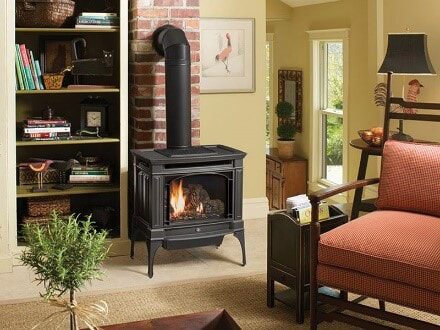A pellet stove is a heating appliance that burns compressed wood or biomass pellets for warmth and comfort. It is energy-efficient, environmentally friendly, and provides consistent heat by using electronically controlled pellets.
With their convenient operation and clean combustion, pellet stoves have gained popularity as an alternative heating solution in many homes. These stoves come in various designs, sizes, and heat output levels to suit different preferences and living spaces. Whether you are looking to reduce your carbon footprint or lower your heating costs, a pellet stove can be an excellent addition to your home.
Its automated features and eco-friendly nature make it a smart choice for modern homeowners seeking sustainable heating solutions.

Credit: termo-plus.com
How Pellet Stoves Work
Have you ever wondered how pellet stoves work? Let’s delve into the science behind these efficient heating appliances.
Fuel And Ignition
Pellet stoves utilize small compressed wood or biomass pellets as fuel.
- The pellets are loaded into a hopper attached to the stove.
- An auger mechanism then automatically feeds the pellets into the combustion chamber.
- Once inside, the pellets are ignited by a heating element.
Heat Distribution
Once the pellets are ignited, the generated heat is distributed throughout the room by a convection fan.
- The fan pushes hot air out into the room.
- At the same time, cooler air is drawn back into the stove for reheating.
Benefits Of Pellet Stoves
A pellet stove is an efficient and eco-friendly heating option that burns compressed wood or biomass pellets. It provides a cost-effective way to heat homes, offering clean and consistent warmth while reducing reliance on traditional fuel sources. The convenient and low-maintenance operation makes pellet stoves a popular choice for environmentally conscious homeowners seeking reliable heating solutions.
Benefits of Pellet Stoves Pellet stoves are an innovative heating option that offer various advantages over traditional wood-burning stoves. Energy Efficiency is one of the key benefits of pellet stoves, as they utilize compressed wood pellets, a sustainable fuel source that produces a consistent and efficient heat output.Energy Efficiency
Pellet stoves are highly energy-efficient due to their automated feeding mechanism that ensures a precise amount of pellets is fed into the stove for optimal burning efficiency. This results in minimal waste and maximum heat generation.Environmental Impact
When it comes to the environmental impact, pellet stoves are a greener alternative to traditional heating methods. They produce lower emissions and utilize renewable wood pellets that are created from recycled wood waste, making them a sustainable heating option.Choosing The Right Pellet Stove
When choosing the right pellet stove for your home, it’s important to consider several key factors to ensure it meets your heating needs and lifestyle. From size and heating capacity to hopper size and maintenance requirements, making an informed decision will ensure you get the most out of your investment.
Size And Heating Capacity
The size and heating capacity of a pellet stove are crucial considerations. Measure the space in which the stove will be placed to ensure the chosen model can effectively heat the area. Look for models with adjustable heat settings to cater to different room sizes.
Hopper Size And Maintenance
The hopper size determines how frequently you’ll need to refill the pellets. Consider your daily routine and opt for a hopper size that aligns with your schedule. Additionally, inquire about the maintenance requirements for each model to ensure it can be easily integrated into your routine.

Credit: www.lanchestergh.com
Installation And Maintenance Tips
Once you have chosen a pellet stove for your home, it’s important to know how to properly install and maintain it for optimal performance. In this section, we will cover some essential tips to ensure that your pellet stove operates safely and efficiently. These tips include proper ventilation, regular cleaning, and inspections.
Proper Ventilation
Proper ventilation is crucial for the safe operation of a pellet stove. Pellet stoves produce exhaust gases, which need to be vented outside your home. Ensure that your pellet stove is installed following the manufacturer’s guidelines and local building codes. It is recommended to hire a professional for the installation process to ensure proper ventilation.
In most cases, pellet stoves require a chimney or a vent pipe system. This system must be designed to handle the specific requirements of your pellet stove. Make sure that the venting system is installed away from any combustible materials and that it provides an adequate draft for proper combustion and venting of the exhaust gases.
Cleaning And Inspections
To maintain the performance and efficiency of your pellet stove, regular cleaning and inspections are necessary. Accumulated ash and debris can affect the stove’s combustion efficiency and potentially cause a fire hazard. Follow these cleaning and inspection tips:
- Clean the firebox: Empty the ash pan regularly to prevent ash buildup. Dispose of ashes in a metal container, as they can remain hot for hours.
- Clean the exhaust system: Inspect the vent pipe and chimney for any obstructions or creosote buildup. Creosote is a flammable byproduct of pellet combustion and should be cleaned to prevent chimney fires. Consider hiring a professional chimney sweep for this task.
- Inspect the gaskets: Check the door gasket and ash pan gasket regularly to ensure they are properly sealed. Damaged or worn-out gaskets can lead to inefficient combustion and air leaks.
- Check the motors and fans: Regularly inspect and clean the motors and fans to ensure they are functioning properly. Lubricate them as recommended by the manufacturer.
- Monitor the hopper: Keep an eye on the pellet hopper, ensuring it is free from debris and pellets are flowing smoothly. Blockages can cause feeding issues and affect the stove’s performance.
By following these installation and maintenance tips, you can enjoy the warmth and efficiency of your pellet stove for years to come. Remember, consulting the manufacturer’s instructions and seeking professional help for installation and annual maintenance is always a good idea.
Economic Considerations
Explore economic considerations of using a pellet stove for efficient heating in homes, offering cost savings and reduced energy consumption. Pellet stoves offer eco-friendly heating options, burning compressed wood or biomass pellets for sustainable warmth. Save money while staying environmentally conscious with a pellet stove.
Cost Comparison
Pellet stoves offer an attractive option for homeowners seeking a cost-effective heating solution. When compared to traditional wood-burning stoves or other heating alternatives, pellet stoves can provide noticeable savings in the long run. Let’s explore the cost comparison in more detail.Potential Savings
Investing in a pellet stove can lead to significant savings on your monthly heating bills. These stoves are designed to efficiently burn wood pellets, which are made from compressed sawdust and other wood waste materials. The cost of wood pellets is generally lower than traditional heating fuel options such as oil or gas.| Heating Fuel | Cost per Unit |
|---|---|
| Wood Pellets | $X per ton |
| Oil | $Y per gallon |
| Gas | $Z per cubic meter |

Credit: diyhomecomfort.com
Frequently Asked Questions Of What Is A Pellet Stove
What Is A Pellet Stove And How Does It Work?
A pellet stove is a heating appliance that burns compressed wood pellets to generate heat. It operates by feeding pellets into a burn pot, where they are ignited and produce combustion gases, which are then vented outside.
Why Choose A Pellet Stove Over Other Heating Options?
Pellet stoves offer several advantages, including high energy efficiency, easy operation, low emissions, and the ability to heat specific zones. They also provide a renewable heating source by using biomass pellets made from recycled materials.
How Much Do Pellet Stoves Cost And Are They Affordable?
The cost of a pellet stove can vary depending on its size, features, and brand. On average, pellet stoves range from $1,500 to $3,000, not including installation. While the initial investment may be higher, the long-term savings on heating costs make them an affordable option.
Are Pellet Stoves Environmentally Friendly?
Yes, pellet stoves are considered environmentally friendly. They utilize wood pellets made from biomass materials, such as sawdust or wood waste, which would otherwise be discarded. These pellets produce low emissions and have a lower carbon footprint compared to fossil fuel-based heating systems.
What Maintenance Is Required For Pellet Stoves?
Regular maintenance for pellet stoves includes cleaning the burn pot, removing ash and creosote buildup, and inspecting the gaskets and vents. It is advisable to have your pellet stove professionally serviced annually to ensure efficient operation and prolong its lifespan.
Conclusion
To sum up, pellet stoves offer an efficient and eco-friendly heating solution for modern homes. With their convenient functionality and low emissions, they are a smart choice for environmentally conscious individuals. By understanding the benefits and operation of pellet stoves, homeowners can make informed decisions about incorporating them into their heating systems.